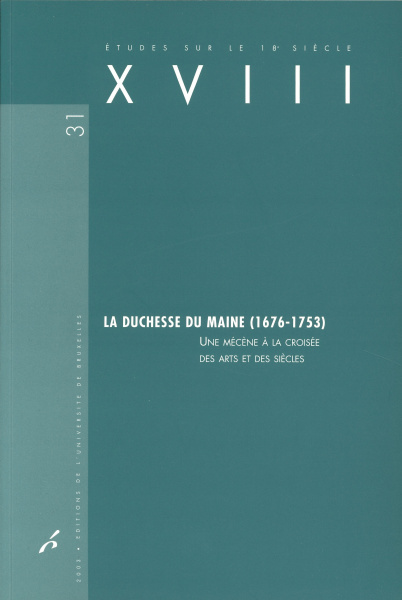La duchesse du Maine (1676-1753)
Une mécène à la croisée des arts et des siècles
Première édition
Cet ouvrage réunit les actes d'un colloque consacré à la vie intellectuelle et artistique qui s'est développée autour de la duchesse du Maine, notamment dans son château de Sceaux. Lire la suite
« Chamarrée », ainsi Saint-Simon qualifiait-il la personnalité complexe d'Anne-Louise-Bénédicte de Bourbon-Condé (1676-1753), précieuse et pédante, frivole mais frondeuse. Sans doute cette excentricité – au sens premier du terme – s’explique-t-elle par un statut social bancal : petite-fille du Grand Condé, membre à part entière de la plus haute aristocratie, celle du sang, elle avait été mariée en 1692 au duc du Maine, l’aîné des bâtards nés du double adultère de la marquise de Montespan et de Louis XIV. Cependant, tout en rappelant à son époux l’infériorité de sa naissance, elle n’aura de cesse – et de plus en plus au fur et à mesure que la mort du roi se rapprochera inévitablement – de le soutenir : à la tête de la conjuration de Cellamare, elle tentera mème de faire enlever la Régence au duc d’Orléans au profit du duc du Maine. Le complot fut déjoué et la duchesse emprisonnée. Ces revers ne l’empêchèrent pas de reprendre ensuite, certes sur un mode assourdi, une vie mondaine et intellectuelle brillante : le président Hénault, Rose de Staal-Delaunay, Fontenelle, Houdar de La Motte ou la marquise du Deffand comptèrent alors parmi ses familiers.
Sa célébrité demeure cependant attachée aux Grandes Nuits de Sceaux, divertissements aussi singuliers que dispendieux par laquelle elle avait su ranimer un temps les splendeurs éteintes de la cour du Roi Soleil. Mêlant poésies galantes, théâtre de société, bals, ballets ou cantates, ranimant le flambeau de la tragédie grecque tout en faisant éclore le genre de l’opéra-comique, les Divertissements de Sceaux témoignent de l’éclectisme de la duchesse et de ses principaux mentors : l’abbé Genest et Malézieu. La réputation de son esprit et plus encore la sûreté de son goût séduisirent les tenants des Anciens comme les plus résolus des Modernes, les célébrités confirmées – Chaulieu, Baron ou Fontenelle – autant que les débutants les plus prometteurs : Mouret, Bourgeois ou Colin de Blamont... C’est à Sceaux que Voltaire fit ses premiers pas dans le monde et c’est à l’intention de la duchesse qu’il écrivit les premiers de ces contes qui devaient les immortaliser tous deux.
Spécifications
- Éditeur
- Éditions de l'Université de Bruxelles
- Édité par
- Catherine Cessac, Manuel Couvreur, Fabrice Preyat,
- Introduction de
- Catherine Cessac, Manuel Couvreur,
- Contributions de
- Roland Mortier, Katia Béguin, François Moureau, Marc Favreau, Nina Lewallen, Gérard Rousset-Charny, Catherine Cessac, Benoît Dratwicki, Anne Delvare, Alain Anselm, Nathalie Lecomte, Fabrice Preyat, François Azouvi, Marianne de Meyenbourg, Ioana Galleron, Nicole Masson, Maurice Barthélemy, Éric Van der Schueren, Manuel Couvreur, Jean-Philippe Grosperrin, Jacques Cormier,
- Revue
- Études sur le XVIIIe siècle | n° 19
- ISSN
- 07721358
- Langue
- français
- Site web ressource
- Oapen.org
- Catégorie (éditeur)
- > Art(s) & Archéologie
- Catégorie (éditeur)
- > Histoire
- Catégorie (éditeur)
- > Langue(s) & Littérature(s)
- BISAC Subject Heading
- HIS037050 HISTORY / Modern / 18th Century
- Code publique Onix
- 06 Professionnel et académique
- CLIL (Version 2013-2019 )
- 3377 HISTOIRE
- Subject Scheme Identifier Code
- Classification thématique Thema: Histoire
Livre broché
- Date de publication
- 09 décembre 2003
- ISBN-13
- 978-2-8004-1326-6
- Ampleur
- Nombre de pages de contenu principal : 288
- Code interne
- 1326
- Format
- 160 x 240 x 22 cm
- Poids
- 559 grammes
- ONIX XML
- Version 2.1, Version 3
Google Livres Aperçu
Sommaire
- Introduction | Catherine CESSAC et Manuel COUVREUR
- La cour de Sceaux, les écrivains et la duchesse du Maine | Roland MORTIER
- Les enjeux et les manifestations du mécénat aristocratique à l'aube du XVIIIe siècle | Katia BÉGUIN
- Complot contre l’État et opinion publique. La duchesse du Maine et la conspiration de Cellamare (1718-1720) | François MOUREAU
- L’inventaire après décès de la duchesse du Maine. Études et commentaires | Marc FAVREAU
- La duchesse du Maine : une mécène d’architecture entre deux siècles | Nina LEWALLEN
- Le duc et la duchesse du Maine Princes bâtisseurs, protecteurs de Germain Boffrand | Gérard ROUSSET-CHARNY
- La duchesse du Maine et la musique | Catherine CESSAC
- François Colin de Blamont à la cour de Sceaux : le jeu des influences et des rencontres | Benoît DRATWICKI
- Un curieux divertissement pour la onzième Grande Nuit de Sceaux : Le comte de Gabalis, de Beauchamps et Bourgeois | Anne DELVARE
- Les clavecins de la duchesse du Maine : lecture des inventaires et approche organologique | Alain ANSELM
- Un maître à danser à la cour de Sceaux : Claude Balon | Nathalie LECOMTE
- Maître des divertissements ou trouble-fête ? Charles-Claude Genest et le Petit Concile à la cour de la duchesse du Maine | Fabrice PREYAT
- Une duchesse cartésienne ? | François AZOUVI
- L’almanach de 1721 et l’emblème de la Mouche à miel | Marianne DE MEYENBOURG
- Les Divertissements de Sceaux face à la querelle des Anciens et des Modernes | Ioana GALLERON-MARASESCU
- Entre création individuelle et collective, la poésie fugitive à la cour de Sceaux | Nicole MASSON
- Chaulieu à Châtenay et à Sceaux | Maurice BARTHÉLEMY
- La tragédie biblique à Sceaux : le Joseph de Charles-Claude Genest (1706) | Éric VAN DER SCHUEREN
- Voltaire chez la duchesse ou Le goût à l’épreuve | Manuel COUVREUR
- La duchesse du Maine et la simplicité du théâtre tragique. Sur la réfection de la tragédie grecque, de Malézieu à La Motte | Jean-Philippe GROSPERRIN
- Les deux dernières comédies de Mme de Staal-Delaunay. Portrait ou pamphlet ? | Jacques CORMIER
- Bibliographie sommaire
- Liste des auteurs

